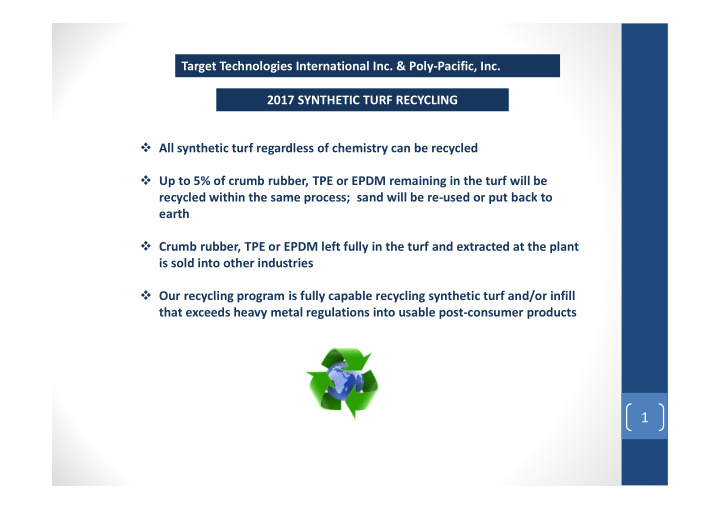



Target Technologies International Inc. & Poly-Pacific, Inc. 2017 SYNTHETIC TURF RECYCLING � All synthetic turf regardless of chemistry can be recycled � Up to 5% of crumb rubber, TPE or EPDM remaining in the turf will be recycled within the same process; sand will be re-used or put back to earth � Crumb rubber, TPE or EPDM left fully in the turf and extracted at the plant is sold into other industries � Our recycling program is fully capable recycling synthetic turf and/or infill that exceeds heavy metal regulations into usable post-consumer products 1
RECYCLING PROCESS 1. Turf is cut into smaller sections 2. Load 95% infill free turf into container 3. Container is shipped to recycling facility 4. Plant unloads container and removes excess infill 5. Turf is cut down to smaller pieces 6. Any contaminants are removed 7. Extrusion (heat & pressure) 8. Molding 9. Cooling 10. Posts 2
RECYCLING REMOVES LIABILITIES � The owner must be fully aware of the synthetic turf and infill’s final destination and its future � The contractor hired to remove the turf and infill bears liability to recycle materials that exceed legal limits according to the law � The freight carrier shoulders liability to move the product environmentally if metals exceed legal limits � The acceptance of the used synthetic turf and infill by the receiver at the final destination bears responsibility If the synthetic turf and infill exceeds the environmental limits and has been moved from the site without proceeding with ‘environmental caution’ then the liability can be in the hundreds of thousands of dollars - ALL PARTIES ARE LIABLE 3
POST-CONSUMER PRODUCTS MUST NOT END UP IN LANDFILLS OR VACANT PROPERTIES � Governments have supported recycling but unfortunately there have been companies paid by government agencies to recycle but produce a product with no end-use � History has proven some recycling companies do not have a market for their final product and they eventually end up in landfills, vacant properties or warehouses � The recycling company of your choice must be able to provide documentation as to where the final product has been sent 4
THE FOUR COMPONENTS REQUIRED FOR RECYCLING WITH THE TTII/POLY-PACIFIC INC. RECYCLING PROGRAM WATER HEAT PRESSURE EXTRUSION 5
6
Recommend
More recommend